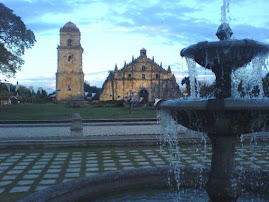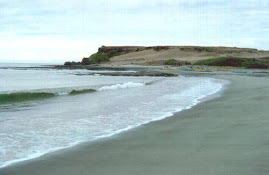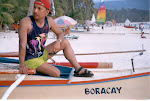 For those non-Ilocanos interested in how empanada is made and why it is so tasty and special, the following photoset shows you how and why.
For those non-Ilocanos interested in how empanada is made and why it is so tasty and special, the following photoset shows you how and why.Dough is made from rice flour.

all about this beautiful town

 The Duque House in Paoay is famous for its one of a kind, octagonal shape. It is still used as residence by the Duque family.
The Duque House in Paoay is famous for its one of a kind, octagonal shape. It is still used as residence by the Duque family. St. Augustine Church, or more popularly called Paoay Church, in Ilocos Norte is one of the the oldest churches in the Philippines and is among the major attractions of Ilocos Norte.
St. Augustine Church, or more popularly called Paoay Church, in Ilocos Norte is one of the the oldest churches in the Philippines and is among the major attractions of Ilocos Norte.



 Historians say: “From the date of early settlement to 1701, little could be said about the activities of the early settlers of Paoay except that much had been done in the clearing of the forests nearby. They converted the forests into rice and sugar lands through the slash-and-burn method called ‘kaingin.’ The early settlers were of a peace-loving tribe, but their major problem was the frequent furious incursions of Sea Rovers and Moro pirates called Tirong who looted indiscriminately their agricultural produce and other valuables. To protect themselves from further incursions, the folks moved towards the nearby inland where the present town proper is now located. In the farther western inland, there were also settlers who formed the neighboring town of Batac. Sensing that the Bombay people had suffered too much from the Moro raids, the people of Batac offered the people of Bombay to live with them. But the brave and maverick folks rejected the offer and instead they uttered "Maka-paoay kami" – an Ilocano dialect jargon meaning they could live independently. The settlers from Batac were offended and it was from this incident that the name of the town came to arrive as PAOAY.”
Historians say: “From the date of early settlement to 1701, little could be said about the activities of the early settlers of Paoay except that much had been done in the clearing of the forests nearby. They converted the forests into rice and sugar lands through the slash-and-burn method called ‘kaingin.’ The early settlers were of a peace-loving tribe, but their major problem was the frequent furious incursions of Sea Rovers and Moro pirates called Tirong who looted indiscriminately their agricultural produce and other valuables. To protect themselves from further incursions, the folks moved towards the nearby inland where the present town proper is now located. In the farther western inland, there were also settlers who formed the neighboring town of Batac. Sensing that the Bombay people had suffered too much from the Moro raids, the people of Batac offered the people of Bombay to live with them. But the brave and maverick folks rejected the offer and instead they uttered "Maka-paoay kami" – an Ilocano dialect jargon meaning they could live independently. The settlers from Batac were offended and it was from this incident that the name of the town came to arrive as PAOAY.” In 1571, when the Spanish conquistadors had Manila more or less under their control, they began looking for new sites to conquer. Legaspi's grandson, Juan de Salcedo, volunteered to lead one of these expeditions. Together with 8 armed boats and 45 men, the 22 year old voyager headed north.
In 1571, when the Spanish conquistadors had Manila more or less under their control, they began looking for new sites to conquer. Legaspi's grandson, Juan de Salcedo, volunteered to lead one of these expeditions. Together with 8 armed boats and 45 men, the 22 year old voyager headed north.
 Shown above are some of the antique furnishings of the cafe
Shown above are some of the antique furnishings of the cafe And what better place to savor the pinakbet pizza and the art of fine dining than at the Herencia Café. The Café boasts of elegance with an Old World feel. Decorations of Florentine glass, antique wood and wrought iron furniture, vigan tiles, and a superb view of the famed Paoay Church combine to create the perfect mood. I was distinctly reminded of Café Intramuros without the hustle and bustle of the city. Indeed a visit to Herencia Café is a glimpse on our genteel past; and a taste of the famed pinakbet pizza, a glimpse into the future of Ilokano cuisine.
And what better place to savor the pinakbet pizza and the art of fine dining than at the Herencia Café. The Café boasts of elegance with an Old World feel. Decorations of Florentine glass, antique wood and wrought iron furniture, vigan tiles, and a superb view of the famed Paoay Church combine to create the perfect mood. I was distinctly reminded of Café Intramuros without the hustle and bustle of the city. Indeed a visit to Herencia Café is a glimpse on our genteel past; and a taste of the famed pinakbet pizza, a glimpse into the future of Ilokano cuisine.  Most pictures of the church I've seen are in landscape mode but this one is in portrait. Friends who've seen this pic say it reminds them of some European churches. This one I took using my Sony Ericsson phone.
Most pictures of the church I've seen are in landscape mode but this one is in portrait. Friends who've seen this pic say it reminds them of some European churches. This one I took using my Sony Ericsson phone.

This picture of one side of the church shows graceful lines

This time a beautiful shot from the back. The greens sprouting from the walls really add beauty to the church. Sadly, they reportedly are slowly weakening the foundation, hence, the plants are regularly pulled out from the walls.





